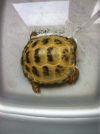

Hi everyone, I've recently moved my tortoise shelly from a glass tank to a new 4' x 2' tortoise table. Although since then Shelly has not been so active she is burrowing down and not eating. I have a 125 watt UVA UVB heat bulb that has been fine for her so far. I thought the table was struggling a bit to keep up the right temp so I added a 7 watt heat mat under the substrate to help but it hasn't changed her behaviour. I feel resigned to let her do what comes natural and let her hibernate but I'm worried I won't do it right can someone give me some points to follow.